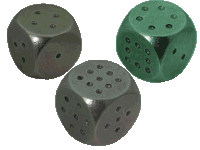Miwin's dice

Miwin's Dice made of titanium
|
|
| Designer(s) | Dr. Michael Winkelmann |
|---|---|
| Publisher(s) | Arquus Verlag Vienna |
| Years active | 1994 |
| Players | 1–9 |
| Age range | 6+, depending on game |
| Playing time | 5–60 minutes, depending on game |
| Website | www.miwin.com |
Miwin's Dice are a set of nontransitive dice invented in 1975 by the physicist Michael Winkelmann. They consist of three different dice with faces bearing numbers from 1 to 9; opposite faces sum to 9, 10, or 11. The numbers on each die give the sum of 30 and have an arithmetic mean of 5.
Miwin's dice have 6 sides, each of which bear a number, depicted in a pattern of dots. The standard set is made of wood; special designs are made of titanium or other materials (gold, silver).
Each die is named for the sum of its 2 lowest numbers. The dots on each die are colored blue, red or black. Each die has the following numbers:
Numbers 1 and 9, 2 and 7, and 3 and 8 are on opposite sides on all three dice. Additional numbers are 5 and 6 on die III, 4 and 5 on die IV, and 4 and 6 on die V. The dice are designed in such a way that, for every die, another will usually win against it. The probability that a given die will have a higher number than another is 17/36; a lower number, 16/36. Thus, die III wins against IV, IV against V, and V against III. Such dice are known as nontransitive.
Each die is named for the sum of its lowest and highest numbers. The dots on each die are colored yellow, white or green. Each die has the following numbers:
Third set:
fourth set:
they have no double numbers and the chance to win is 5/9.
Each of the dice has similar attributes: each die bears each of its numbers exactly once, the sum of the numbers is 30, and each number from 1 to 9 is spread twice over the three dice. This attribute characterizes the implementation of intransitive dice, enabling the different game variants. All the games need only 3 dice, in comparison to other theoretical nontransitive dice, designed in view of mathematics, such as Efron's dice.
The probability for a given number with all 3 dice is 11/36, for a given rolled double is 1/36, for any rolled double 1/4. The probability to obtain a rolled double is only 50% compared to normal dice.
Cumulative frequency type III and IV
Cumulative frequency type III and V
Cumulative frequency type IV and V
Cumulative frequency type III and IV and V = "Miwin-Distribution"
Removing the common dots of Miwin's Dice reverses intransitivity.
Miwin's dice facilitate generating numbers at random, within a given range, such that each included number is equally-likely to occur. In order to obtain a range that does not begin with 1 or 0, simply add a constant value to bring it into that range (to obtain random numbers between 8 and 16, inclusive, follow the 1 – 9 instructions below, and add 7 to the result of each roll).
...
Wikipedia
